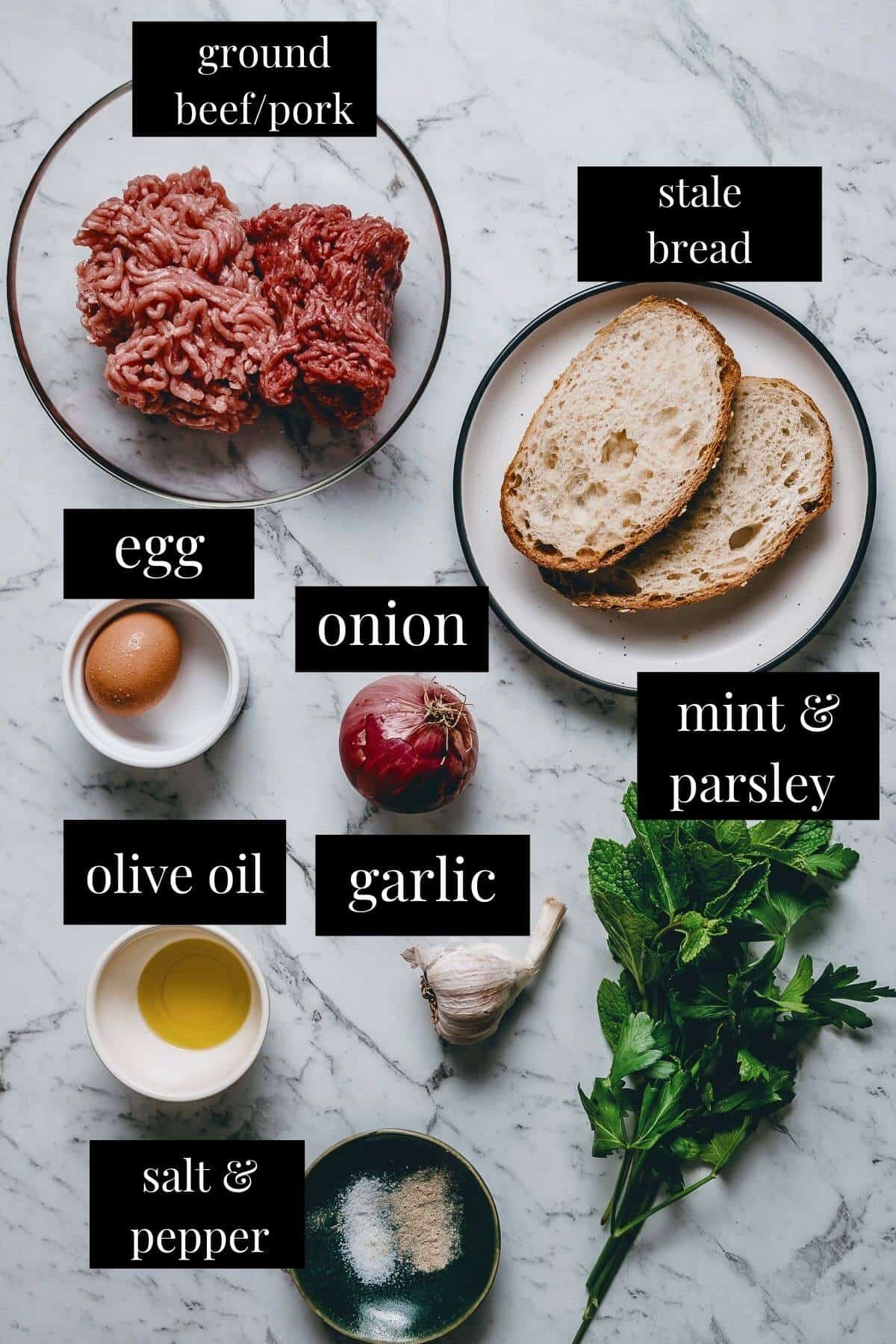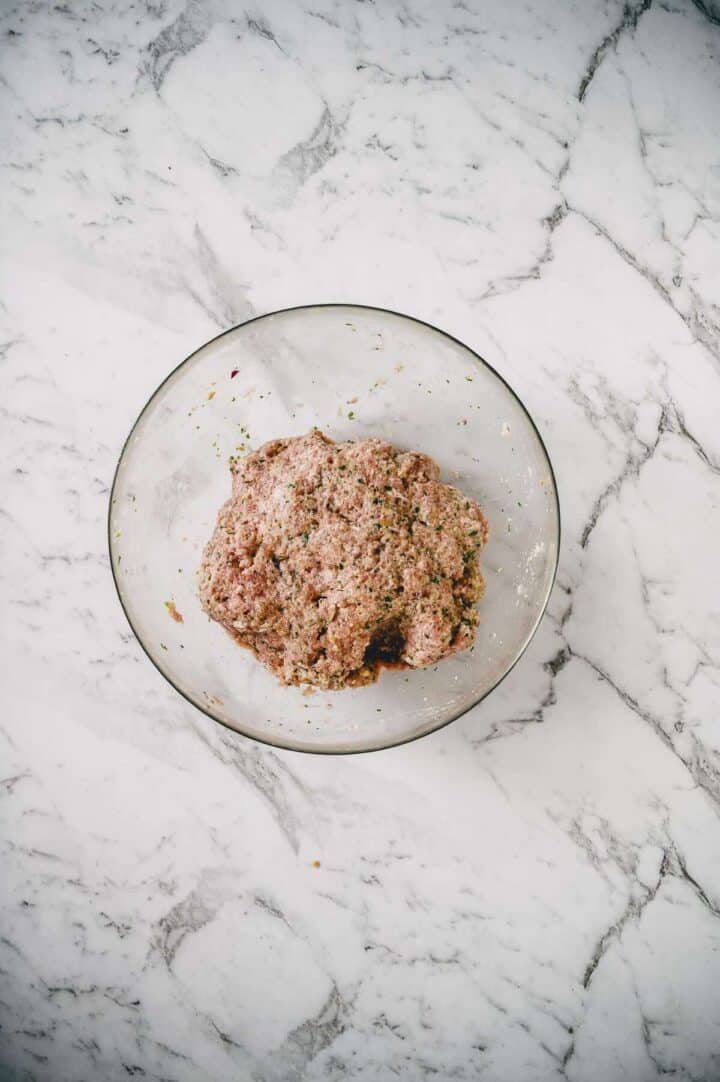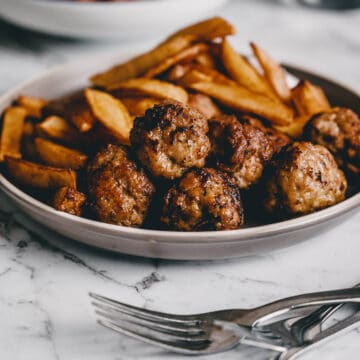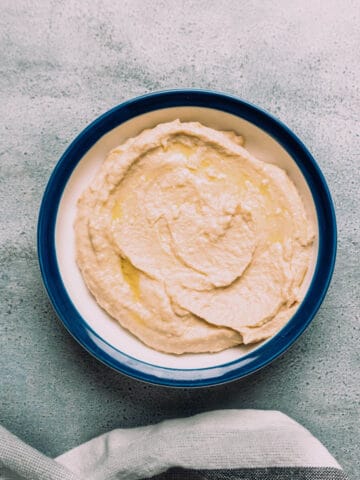When it comes to Greek food, keftedes (Greek meatballs) should be in their own food group — that’s how good they are! Easy to prepare and loved by all, they’re popular for a reason. My Greek meatball recipe will show you how to make these perfect little beauties with simple, everyday ingredients.

CONTENTS
Why this recipe works
- Keftedes are “parcels of perfection”. I can guarantee you, once you’ve tried my Greek meatballs you will agree how good they are - crispy on the outside and juicy on the inside. No-one will be able to resist them! (And there are no breadcrumbs in sight!).
- Keftedes are incredibly easy to prepare. My recipe uses everyday ingredients found in your kitchen. Apart from a little shallow frying, making these easy Greek meatballs from scratch isn’t as hard as you think. I even show you a little trick to speed up the process using a food processor.
- They are extremely versatile. Serve the keftedes as an appetizer along with some Greek salad and pita bread and you have the perfect grazing platter. Or, turn them into a main meal and serve them with roasted Greek potatoes known as “patates sto fourno” and some tzatziki on the side.
Related: For another traditional Greek recipe see my makaronia me kima (Greek spaghetti) recipe.
Ingredients

- Ground Meat - When making keftedes use a combination of lean ground beef and ground pork. I find the pork adds extra fat and flavour. If you’re not a fan of pork use all ground beef instead - just make sure to add a little extra olive oil to compensate for the fat we lose from not using the pork.
- Bread - I consider this the “secret” ingredient. Unlike breadcrumbs, I find the bread (once it’s been moistened in water) helps make the keftedes light, soft and juicy. Be sure to use bread thats a few days old (not fresh bread).
- Onion - grate your onion for best results or use a food processor like I do. Combined with the bread it helps form a paste that we combine through the mince meat.
- Greek olive oil - Along with the bread and onion, the olive oil is another ingredient which helps to keep our meatballs soft.
- Garlic - one clove is enough. Don’t overdo it! The garlic adds a nice background aroma — we don’t want it permeating the whole recipe. Omit the garlic if you prefer not to cook with it.
- Herbs - Greek meatballs traditionally use mint. This is almost a “signature” flavour. However, I like to add a little parsley for freshness and sometimes I like to use a “hint” of dried Greek oregano.
- Egg - acts a binder. If you don’t like eggs or have an allergy try using a chia or flax egg.
- Salt and pepper - it's important to season our meat mixture. I find a teaspoon of salt is perfect for this amount. And I prefer to use white pepper. You can substitute with cracked black pepper if your prefer.
- Ouzo - what would a Greek meatball recipe be without ouzo? In all seriousness, if you have any on hand try it! And a little goes a long way!
- Flour - keftedes are traditionally dredged in flour before frying. This helps produce a beautiful, crisp crust.
Instructions


Place the bread in a bowl of water and allow it to soak for a few seconds (make sure it’s fully submerged). Using your hands, squeeze the excess water out of the bread. Place in the food processor.


Along with the soaked bread, add the onion, parsley and mint and mix until a soft paste forms.


In a separate bowl combine the ground meat, the bread paste, egg, garlic, olive oil and ouzo (if using). Using your hands, mix all the ingredients together until well combined. Make sure the keftedes mixture is homogenous.


Place the flour on a large plate. Take one tablespoon of the mix, roll into a ball and place on the floured plate. Roll the keftedes in the flour, shake off any excess flour and place on a baking tray. Repeat for the remainder of the mixture and place in the refrigerator for 15 mins.
Bonus Tip: Use a small ice cream scoop to form the Greek meatballs - it’s quick and you end up with perfectly shaped balls.

Heat the olive oil in a fry pan on a medium heat and shallow fry the keftedes until browned all over (this should take approx. 5-10 minutes).
Top Tip: Don’t overcrowd the pan. Depending on the size of your pan, fry in small batches to ensure even cooking.

Expert Tips
- Mix everything really well. It’s important to really “get into it” with your hands and mix all the ingredients well. This process can take up to five minutes and ensures we end up incorporating everything evenly.
- Use the right oil when frying your Greek meatballs. Greeks traditionally use olive oil when frying keftedes. However, if you find it’s a little heavy for your palate try a lighter flavoured olive oil, canola oil or sunflower oil.
Bonus Tip: If you don’t like frying, try baking them. Preheat your oven to 180 deg C and place the keftedes on lined baking tray (don’t flour them) and cook for 15-20 mins until browned all over
- Add a little cheese. If you want to take this Greek meatballs recipe to the next level add half a cup of crumbled feta cheese or kefalograviera cheese (the same cheese used to make fried saganaki). It adds a lovely flavour and everyone knows that cheese makes everything taste better!
👨🍳 Cooks Tip: Try dressing the keftedes with some ladolemono (Greek olive oil and lemon sauce) for something different.

Recipe FAQ's
Keftedes are pronounced as ke-fte-thes. The “d” sounds as a “th” in Greek (like in the word "the").
Yes. After you roll them (don’t flour them) place them on a lined baking tray and pop them in the freezer for 15 mins. Remove and place in your favourite container or ziplock bag. Cook from frozen in a preheated hot oven for 25 mins until browned and cooked through.
Place the previously cooked meatballs on a lined baking tray, cover lightly with foil and cook in a preheated 150 deg C oven for 15 mins. until warmed through.
Video
More delicious meatballs
📋 Recipe

Keftedes - Greek Meatballs
Ingredients
- 120 grams bread, day old, approx. 2 slices
- 1 onion, medium size
- 250 grams ground beef
- 250 grams ground pork
- 1 ½ tablespoon mint, fresh
- 1 tablespoon parsley, fresh
- 1 egg
- 1 tablespoon olive oil
- 1 garlic clove
- 1 teaspoon salt
- 1 tablespoon ouzo, optional
- 1 teaspoon white pepper
- 75 grams plain flour, for dredging
- olive oil, for frying
Instructions
- Place the bread in a bowl of water and allow it to soak for a few seconds (make sure it’s fully submerged). Using your hands, squeeze the excess water out of the bread. Place in the food processor.
- Along with the soaked bread, add the onion, parsley and mint and mix until a soft paste forms.
- In a separate bowl combine the ground meat, the bread paste, egg, garlic, olive oil and ouzo (if using). Using your hands, mix all the ingredients together until well combined.
- Place the flour on a large plate. Take one tablespoon of the mix, roll into a ball and place on the floured plate. Roll the keftedes in the flour, shake off any excess flour and place on a baking tray. Repeat for the remainder of the mixture and place in the refrigerator for 15 mins.
- Heat the olive oil in a fry pan on a medium heat and shallow fry the keftedes until browned all over (this should take approx. 5-10 minutes). Drain on paper towels while cooking the remainder of the meatballs.
Notes
- Mix everything really well. It’s important to really “get into it” and mix all the ingredients well. Don’t be afraid to use your hands. This process can take up to five minutes and ensures we end up with a well combined meatball mixture.
- Use the right oil when frying your Greek meatballs. Greeks traditionally use olive oil when frying keftedes. However, if you find it’s a little heavy for your palate try a lighter flavoured olive oil, canola oil or sunflower oil.
- Bonus Tip: If you don’t like frying, try baking them. Preheat your oven to 180 deg C and place the keftedes on lined baking tray (don’t flour them) and cook for 15-20 mins until browned all over.
- Add a little cheese. If you want to take this Greek meatballs recipe to the next level add half a cup of crumbled feta cheese or kefalograviera cheese (the same cheese used to make fried saganaki). It adds a lovely flavour and everyone knows that cheese makes everything taste better!
Nutrition
This website provides approximate nutrition information for convenience and as a courtesy only. Nutrition data is gathered primarily from the USDA Food Composition Database, whenever available, or otherwise other online calculators.
© Souvlaki For the Soul






R
Thank you for this wonderful recipe. My only departure from your recipe is the use of Pernod instead of ouzo (because I don’t have ouzo). Nonetheless it turned out very well.
Sophia
These were so delicious- very juicy and tender. I've been looking for a good recipe for keftedes and I will definitely be making these again! Thank you, Peter!
Gayl Gray
Thank u/ I wanted to know more about how to serve like with what sauce, etc. I like you are upbeat and informative.
Peter G
Serve with tzatziki (recipe from my site).